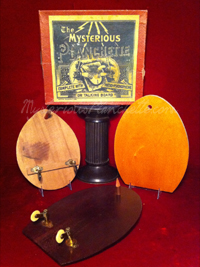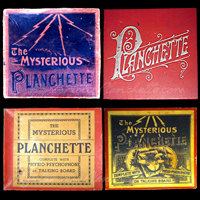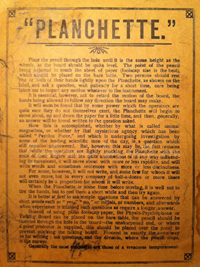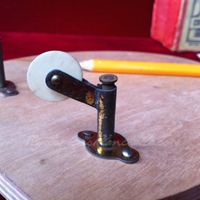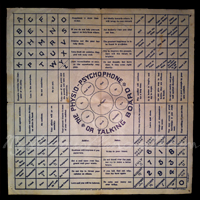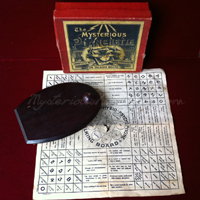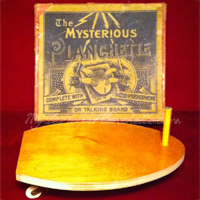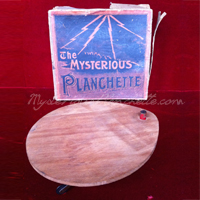The most enduring mystery planchette for this researcher is not only the most aptly named of all other boards, but also inspires the name of our website! The "Mysterious Planchette" is among the most common of planks, but also the most resistance to proper manufacturer identification and, therefore, dating. No manufacturer's name graces the boxes or papers other than a vague "Made in England" and "British Manufacture," which gives this category of boards its name. We know they were available in 1923 thanks to an ad by the Foy & Gibson stationary store, but that's about all we've got to go on. Of course we hate to wager on guesswork!
Glevum Games was established in 1894 in Gloucester, England, by the Roberts Brothers, namely Harry Owen and John Owen, and produced a range of furniture, toys, and games, being the largest toy manufacture in Britain for a time. There first product was the game Piladex, which was little more than a balloon, created for a local church youth club, and went on to become a household name after a royal endorsement. They built the Glevum Works factory in 1902, which employed upwards of 700 workers, and even took extraordinary steps for the age of providing ventilation and central air to combat the stifling temperatures produced by the production line, so that their employees could remain comfortable. Apparently, the conditions were so ideal that it became a model to which government inspections referred other factories. After a long period of production, Chad Valley took over the company's factory, which was closed two years later.
No one knows why Glevum Games concealed their identity on the planks. It may be that the toy company didn't wish to advertise on a potentially controversial product, although these planchettes all carry a common thread beyond the boldly-printed "British Manufacture" stamp. Their boxes hold the first clues to their close relationship, most bearing a variation of the intriguing "lightning bolt" woodcut lithograph that features lightning striking through the board's name. The earliest box label accompanies a petite planchette in a small, flimsy box with metal-reinforced corners, the sparks of electricity arching through a red-and-black, duo-tone print of the contents' name. Later versions expand on this theme, with lightning hurtling ground-ward toward two users, their pictured hands gingerly placed upon the board as it scribbles out an answer from beyond. But lightning bolts and spiritual conduction don't grace every box. Two other notable examples exist?one much plainer, with bold letter type, and another with stylized silver lettering. Despite the differences in these exterior labels, all boxes carry identical inner instruction labels -with only the red label box's different type set and font being an exception -making their identity as a family absolute.
The castors among all models match identically, with one notable exception of black plastic wheel versus the regular white wheels, but are of the typical pentagraph stamped tin style, attached to the board with tiny finishing nails. The distinctive sleeved retaining rivet is perhaps the easiest identifier of this company's castors, which differs from similar Chad Valley castors with the distinctive, oversized "tackhead" rivet.
Perhaps most importantly, all of the specimens were packaged with the mind-numbingly named "Physio-Psychophone," a 4-panel, fold out sheet ostensibly used in place of prophetic spirit scribblings to point users toward their fates with colorful snippets of fortunes such as the promising "You Will Be More Fortunate in Old Age," the bachelor's dream "Delay Marriage," the heartfelt "Love and You Will Be Beloved," and the Yoda-esque "Be Not Suspicious."
Despite the key points of similarity that allow us to assign this group to a single source, a fairly wide variety of boards exist among the so-called "British Manufacture" category. The most common and highest quality board seems to be a deeply red-stained, flat-backed, blunt-nosed planchette. These models can be easily spotted by the "bubble" shaped pencil retainer. Made of wood and glued to the top of the board, this 1-inch diameter half-sphere is unmistakeable. The craftsmanship far outpaces other planks of this maker, with a nicely beveled edge and the perfect weight at 5/16-inch thick. The castors, though of the same recycled pentagraph quality as the rest of the boards of this category, are at least mounted directly to the board, rather than to a rough strip of wood common on some of the lesser models.
This planchette has been discovered in the widest range of boxes?all but the one smallest variation, in fact. In addition to the common "lightning bolt" lithographed box in the larger size, it has also been discovered in beautiful burgundy boxes with "Planchette" spelled in silver, sweeping, beautifully stylized letters. Of course, versions also exist in the most plain boxes imaginable, with comparatively simple lettering in bold block print and a subdued double border, stating simply the names of the embedded contents.
Next in quality are the "blond boards." These planks carry the same flat-rear and round-nose shape as their dark-stained siblings, but are 3/4-inch shorter, missing some of the details that make the planchettes described above a higher quality product. The edges are straight-cut, lacking the meticulous bevel of its sister, and while the wood is smoothly sanded on the underside, the orange-tinted varnish is restricted to the top only. It has the same castors as all British Manufacture planks, and, like its darker sibling, they are mounted directly to the board with two small finishing nails without penetration to the top side. In at least one instance, a brass plug serves as a pencil clamp, though this seems to be an exception to a simple hole, rather than the rule. To date, these boards can be found in both the lightning-bolts-and-hands lithograph variant, as well as the stylized silver burgundy box, although such boxes are slightly smaller.
The final board so far discovered in this category is something of the ugly, red-headed stepchild of the family. Analysis of the board, printing style, and box graphics seem to indicate that this version is a predecessor of the others. The box is the duo-tone "red label," similar to the more detailed version and including the spiritual sparks, but lacking the pairs of hands, planchette woodcut, and scrolling banners. The box is the smallest of all variants at only 5.5 x 6 inches, and the planchette is positively petite compared to its younger sister?indeed the runt of the litter. But things only get worse for this poor plank. While cursed with the same cheap, pressed-tin castors as its siblings, albeit with black wheels, they are mounted on a thin strip of wood, rather that to the board itself. But the infraction hardly matters. The rough-cut board appears as if it was hand cut with a hacksaw, with an inconsistent, asymmetrical shape that would border dangerously close to a paisley if the woodworker had much more to drink. The board is totally devoid of varnish, character, or even a proper sanding, with the oil stains from years of fingerprints actually working in the board's favor, giving it a few shiny spots in a sea of rough wood grain. One might speculate that they were produced during the lean years of WWI, for some dreadful calamity must have befallen the manufacturer. Rarely do we group planchettes in with the "toys" they were often marketed as, but if any one qualifies, it would be this one. Ages 10 and below only, please.






